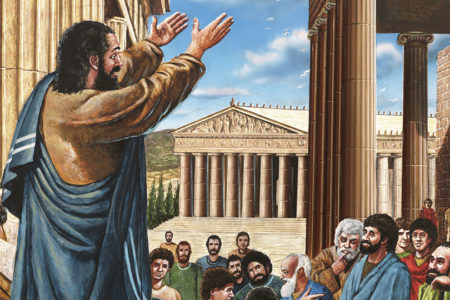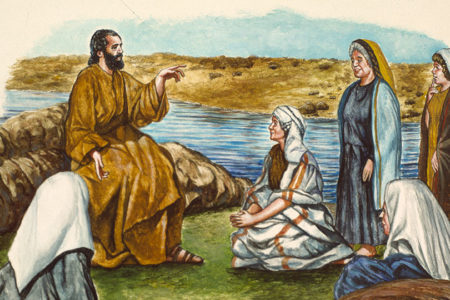Paul’s Encounter With the Risen Savior
Regarding the miraculous turnabout of Rabbi Saul, Church historian Philip Schaff, states, “The transformation of the most dangerous persecutor into the most successful promoter of Christianity is nothing less than a miracle of divine grace. It rests on the greater miracle of the resurrection of Christ.” The world was to know this former rabbi as the apostle Paul. Little did he realize how his decision to believe and follow the risen Jesus would impact the course of human history. The account of Paul’s confrontation with the Lord and subsequent decision to follow Him is extraordinary. It caused him to reexamine his Pharisaic concepts concerning the Law, resurrection, and religious good works in the light of Scripture.
Outside of the Light of God
The verdict from Caiaphas was that Jesus of Nazareth was guilty of blasphemy, the penalty for which was death by stoning (Lev. 24:16). Yet Jesus was crucified on a cross, and therefore, in Pharisaic notion, He had incurred an additional curse from God (Dt. 21:23). To the young, impassioned rabbi from Tarsus, this meant that all who held the position that Jesus was the Son of God who had risen from the dead were deserving of death. He considered it a clear case of schemed slander to the decree and sacred name of Ha Shem (The Name).
Paul therefore sanctimoniously agreed to the murder of Stephen (Acts 8:1). His stonelike convictions compelled him to search out members of the “way” (Acts 9:2) for persecution. Daily, without any sense of shame, he entered the houses of Jewish believers and ravaged their lives. Men and women, even children, were chained and brazenly hauled through the crowded streets of Jerusalem. They were then thrown into loathsome prison stalls to await their fate. Some were tortured; many others found peace through death (Acts 8:3). In raging fury, Paul persecuted and sacked the Church of God beyond measure. Yet, although scattered and hunted, the followers of the risen Jesus continued to preach the Word (Acts 8:4).
Paul desired to press his campaign of repression to foreign cities (Acts 22:5; Gal. 1:13). Appointed Chief Rabbinical Inquisitor by the high priest in Jerusalem, Paul set out toward the Pearl of the Desert, Damascus. It was near this city that God answered the cries of His badgered flock by offering Paul something far more precious than a pearl.
Struck by the Light of the Risen Jesus
Most of the long journey was uninspiring. It no doubt offered countless hours for Paul to chant his Shemoneh Esreh. These 18 ancient prayers were designed to keep alive the spirit of expectancy of God’s promises, and all Pharisees were to recite them three times a day. The second prayer pointed to the confidence of the resurrection:
Thou, Lord, art mighty to eternity, Thou raisest the dead, Thou art mighty to save. In kindness He satisfieth the living, in great pity He raiseth the dead; He upholdeth those that fall; He healeth the sick and setteth free them that are bound; He will manifest His faithfulness to those who sleep in the dust. Who is like the Lord on high, and who is like Thee, Thou King, Who killest and makest alive, and causest salvation to spring forth? Faithful art Thou to restore life to the dead; blessed be the Lord who restoreth life to the dead.
It is likely that as he mulled over these words, the alleged resurrection of Jesus ruffled his thoughts. After all, wasn’t Jesus a blasphemer and therefore anathematized? The claim that Jesus had risen from the dead implied that God had reversed the divine curse of Deuteronomy 21:23. Gamaliel never taught or suggested such a thing. Stephen’s declaration before his death that he had seen “the Son of man standing on the right hand of God” (Acts 7:56) seemed absurd. Such foolishness only stirred Paul to venture forward, “breathing out threatenings and slaughter” (Acts 9:1) as he endeavored to destroy the followers of Jesus.
As they approached Damascus near midday, a light “above the brightness of the sun” (Acts 26:13) suddenly flashed, and Paul was thrown violently to the ground. A heart-penetrating voice sounded: “Saul, Saul, why persecutest thou me?” (Acts 9:4). Reverently, Paul asked who it was who spoke. “I am Jesus, whom thou persecutest” (Acts 9:5) was the reply. What a shock! Paul, who could not accept the fact that the hanged one had risen from the dead, actually saw and heard the resurrected Messiah (Acts 9:27; 1 Cor. 15:8). All of his religious suppositions concerning the resurrection were shattered. He realized that God did approve of Jesus’ life and ministry. Blessed be the Lord who restores life to the dead. Blinded from the blast of light, Paul was instructed to enter the city and wait.
Called to the Light of Salvation
Inside Damascus, Paul remained sightless. Perhaps in the dark recesses of his mind, he finally saw how he had twisted the truth of Scripture with rabbinical traditionalism and how, when mixed together, they blinded him to the truth about Jesus.
Ananias, a faithful follower of the “way,” was instructed to visit Paul and lay hands on him. Immediately Paul’s sight returned. He then identified with the people he had previously hated by being baptized and entering the synagogues—not to persecute the disciples of Jesus but to preach that Jesus is the Messiah, God the Son (Acts 9:18–20). This was a miraculous turnabout for Paul, who was born again, not of the flesh but of the Spirit, “as of one born out of due time” (1 Cor. 15:8).
Paul was converted that day on the Damascus road. This did not mean that he lost his ethnicity or love for his people Israel. Rather, it meant that God Himself had produced in Paul a change of heart resulting in a change of mind about what his religious training suggested was the way to God, as opposed to what the Scriptures taught. Now, under the illumination of the indwelling Holy Spirit, he was given “the light of the knowledge of the glory of God in the face of Jesus Christ” (2 Cor. 4:6).
In spite of his past sins, God had shown him mercy. He accepted his commission to be a faithful “witness unto all men of what he had seen and heard” (Acts 22:15). His testimony is contained in these words: “Who was before a blasphemer, and a persecutor, and injurious; but I obtained mercy … This is a faithful saying, and worthy of all acceptance, that Christ Jesus came into the world to save sinners, of whom I am chief” (1 Tim. 1:13, 15).
Through the light of the risen Savior, Jesus, Paul clearly understood the Scriptures. God’s enlightenment caused him to rethink three areas of his Pharisaic doctrines.
His Understanding of the Law
“He who is hanged [on a tree] is accursed by God” (Dt. 21:23b).
Paul now knew that Caiaphas had been wrong in charging Jesus with blasphemy. Jesus was who He claimed to be—He was God in the flesh who walked among men, the second person of the triune God (Phil. 2:6). The paradox of the Law, which pronounced a divine curse on a hanged man, was explained through the power of the Holy Spirit, revealing to Paul that the crucifixion was essential to the redemptive work of Messiah: “Christ hath redeemed us from the curse of the law, being made a curse for us; for it is written, Cursed is everyone that hangeth on a tree” (Gal. 3:13). With this revelation, Paul was never ashamed to acknowledge the hanged one to all people: “For I determined not to know any thing among you, except Jesus Christ, and him crucified” (1 Cor. 2:2). Paul realized that the Law was designed as a schoolmaster to lead people to Christ (Gal. 3:24) and that Christ was the end of the Law for righteousness to everyone who would believe (Rom. 10:4).
His View of the Resurrection
“If Christ be not raised, your faith is vain, ye are yet in your sins” (1 Cor. 15:17).
Two extreme Pharisaic views on the resurrection were shattered that day on the Damascus road. The first was that the resurrection was reserved only for Israel, and the second was that the resurrection was reserved only for the righteous and not for the wicked. Paul now realized that God had exhibited His approval of Jesus by raising Him from the dead (Acts 13:29–35). Also, he preached that anyone who receives God’s righteousness by faith through Jesus can be certain of a glorious resurrection (Rom. 6:4–5). Paul taught, through the illustration of the ancient agricultural festival of Firstfruits, that Jesus’ resurrection was the “first fruits” of many who will one day rise from the dead (1 Cor. 15:20, cp. 6:14).
His Religious Pride and Good Works
“Concerning zeal, persecuting the church; touching the righteousness which is in the law [written and oral], blameless. But what things were gain to me, those I counted loss for Christ” (Phil. 3:6–7).
Paul radically broke away from Pharisaic Judaism with its belief in righteousness based on legalism and tradition. His personal encounter with the resurrected Jesus revealed to him that righteousness was not attained by religious works (Rom. 3:20). Rather, it rests on the fact that God made Jesus become sin for us so that we may obtain the righteousness of God through faith in Him (2 Cor. 5:21). Leaving behind his empty religiosity, Paul placed himself at the mercy of God and accepted Jesus Christ for his needed justification. This was a free gift and was not attained through his good works.
Paul was forever changed. He devoted the remainder of his life to preaching one message: “that Christ died for our sins according to the scriptures; And that he was buried, and that he rose again the third day according to the scriptures” (1 Cor. 15:3–4). This was the good news that Paul encountered on that ancient road. It is still the good news today. Would you like to consider knowing personally what Paul encountered that day? You can if you will accept by faith the resurrected Savior, Jesus Christ.








I FIND THESE READINGS VERY UPLIFTING AND WOULD LIKE TO BE CONNECTED TO YOU GUYS.